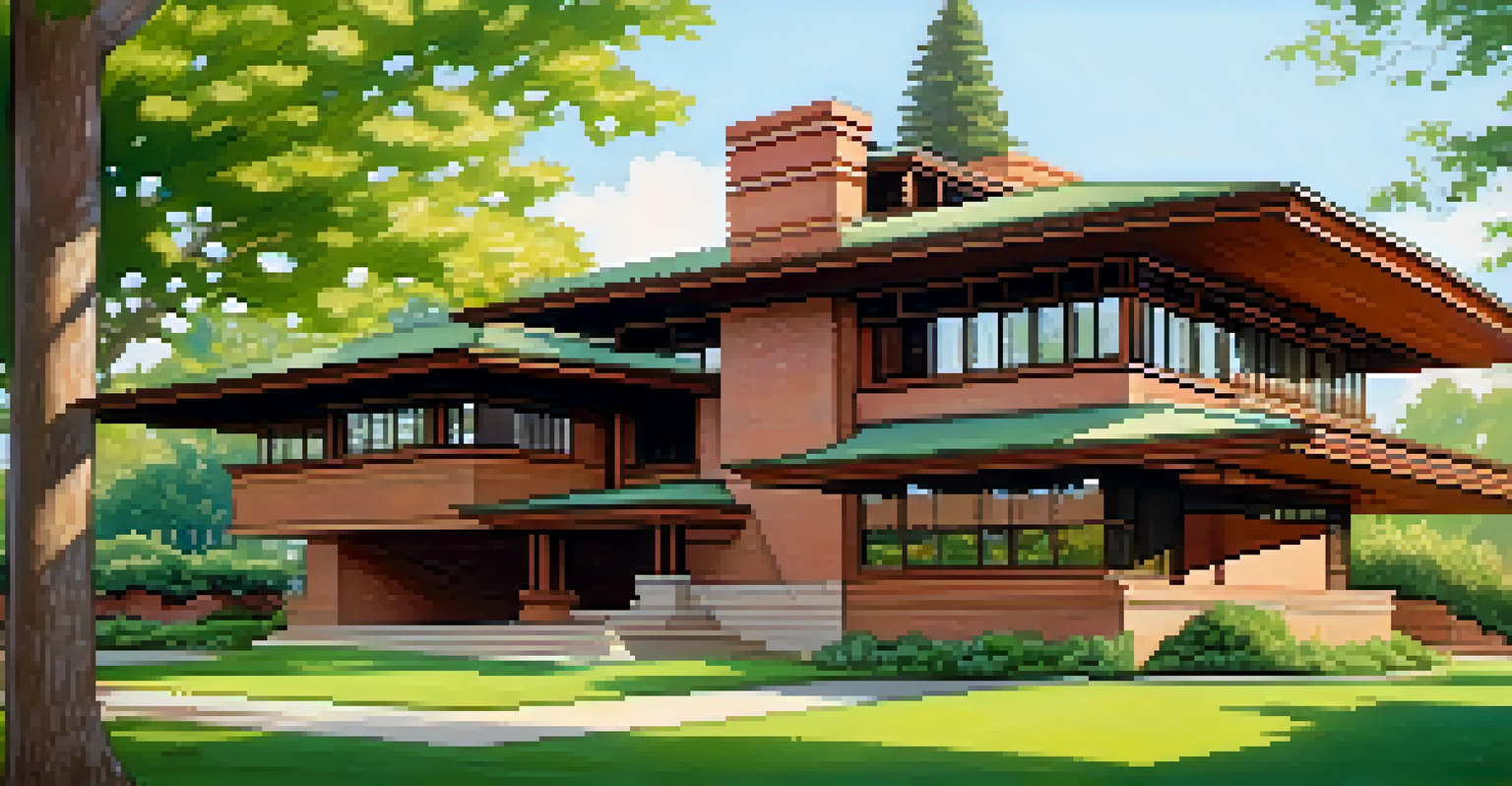Architecture of Buffalo: Historic Buildings and Landmarks

An Overview of Buffalo's Architectural Landscape
Buffalo, New York, is a treasure trove of architectural styles that tell the story of its history and culture. From neoclassical to modernist designs, the city's skyline reflects the evolution of American architecture. The diversity of its structures not only showcases artistic innovation but also highlights the city's economic progress over the decades.
Architecture is the learned game, correct and magnificent, of forms assembled in the light.
As you wander through Buffalo, you'll notice how various architectural styles harmoniously coexist, creating a unique urban tapestry. Historic districts like Allentown and the Waterfront are particularly notable for their well-preserved buildings, which draw locals and tourists alike. Each structure has its own story, making Buffalo a living museum of architectural achievement.
This rich architectural heritage is something that Buffalo takes pride in, fostering a sense of identity among its residents. More than just buildings, these landmarks embody the spirit and resilience of the city, inviting everyone to explore their fascinating narratives.
The Iconic City Hall: A Symbol of Buffalo
Buffalo City Hall, completed in 1931, is one of the most recognizable landmarks in the city. This towering structure, designed in the Art Deco style, stands as a testament to Buffalo's historical significance and ambition during the early 20th century. Its stunning exterior features intricate carvings and a monumental clock tower that looms over the city.

Visitors can take an elevator to the observation deck for a breathtaking panoramic view of Buffalo and beyond. The building's grand lobby is equally impressive, adorned with beautiful murals that depict the city's history. City Hall is not just a government building; it's a celebration of Buffalo's past, showcasing the craftsmanship of its era.
Buffalo's Architectural Diversity
Buffalo showcases a rich tapestry of architectural styles that reflect its historical and cultural evolution.
Moreover, City Hall plays a vital role in the community, serving as a hub for civic engagement and local governance. It's a place where history and progress meet, reminding residents of their roots while inspiring future generations to continue building a vibrant city.
The Historic Darwin D. Martin House Complex
Designed by the legendary architect Frank Lloyd Wright, the Darwin D. Martin House is a masterpiece of the Prairie School movement. Built between 1903 and 1905, this residence is renowned for its innovative design, which emphasizes harmony with nature and the surrounding landscape. The complex includes multiple buildings, showcasing Wright's vision of a cohesive living environment.
We shape our buildings; thereafter they shape us.
Visitors can explore the intricate details of the house, from the stunning stained glass windows to the open floor plan that invites light and air into the living spaces. The design of the Martin House reflects an early 20th-century ethos, emphasizing function, craftsmanship, and a connection to the outdoors. It's a prime example of how architecture can create a sense of place and belonging.
Today, the Darwin D. Martin House is a designated National Historic Landmark, attracting architecture enthusiasts and curious visitors alike. It serves as a reminder of Buffalo's rich architectural history and the importance of preserving such cultural treasures for future generations.
The Allentown Historic District: A Walk Through Time
The Allentown Historic District is one of Buffalo's most charming neighborhoods, filled with Victorian-era homes and eclectic architecture. This area has retained much of its historic character, making it a popular destination for those looking to experience the city's past. As you stroll through the tree-lined streets, you'll encounter a variety of architectural styles, including Italianate, Gothic Revival, and Queen Anne.
Allentown's vibrant arts scene complements its architectural beauty, with galleries, boutiques, and theaters contributing to the area's lively atmosphere. The neighborhood is not only a feast for the eyes but also a hub for culture and community engagement. Events like the Allentown Art Festival celebrate local artists and foster a sense of pride among residents.
Significance of Preservation Efforts
Preservation initiatives in Buffalo are crucial for maintaining the city's architectural heritage and fostering community pride.
Preservation efforts have ensured that Allentown remains a beloved part of Buffalo's history. The district is a testament to the city's commitment to honoring its architectural heritage while continuing to evolve into a modern, thriving community.
The Buffalo Central Terminal: A Look at Transportation History
The Buffalo Central Terminal, once a bustling hub of railway activity, is an architectural gem that stands as a reminder of the city's transportation history. Completed in 1929, this Art Deco masterpiece features stunning design elements, including a grand waiting room and soaring clock tower. Despite its decline in the latter half of the 20th century, the terminal remains a symbol of Buffalo's past prosperity.
Today, efforts are underway to restore and revitalize the Central Terminal, transforming it into a community space that honors its historical significance. The building's unique architectural features, such as its vibrant tile work and ornate ceilings, draw visitors who appreciate its grandeur and historical importance. Tours of the terminal often reveal hidden treasures and stories from its vibrant past.
The Buffalo Central Terminal is not just a relic of the past; it's a canvas for future possibilities. Its revival symbolizes the community's dedication to preserving its history while embracing new opportunities for growth and development.
The Albright-Knox Art Gallery: A Cultural Landmark
The Albright-Knox Art Gallery is a cultural landmark in Buffalo, housing an impressive collection of modern and contemporary art. Established in 1862, the gallery has undergone several renovations, with the most recent expansion designed by the renowned architect OMA. The building itself is a work of art, blending innovative design with a commitment to showcasing creativity.
Inside, visitors can explore a diverse array of artworks, ranging from masterpieces by famous artists to thought-provoking installations. The gallery's dedication to art education and community involvement makes it a vital part of Buffalo's cultural fabric. Special exhibitions and events engage audiences of all ages, fostering a love for the arts.
Cultural Landmarks Enhance Community
Iconic structures like the Darwin D. Martin House and the Albright-Knox Art Gallery serve as vital cultural hubs that connect residents to their history.
The Albright-Knox is more than just an art gallery; it's a hub for artistic expression and dialogue. It symbolizes Buffalo's commitment to embracing creativity while preserving its architectural heritage, making it a must-visit for art enthusiasts and casual visitors alike.
The Rich Legacy of the Buffalo State Hospital
The Buffalo State Hospital, designed by architect H.H. Richardson in the late 19th century, is a prime example of Romanesque Revival architecture. Its imposing structure and sprawling grounds reflect a progressive approach to mental health care during its time. The hospital is not only noteworthy for its design but also for its significant role in the history of mental health treatment in the region.
The building features distinctive elements, such as rusticated stone walls and intricate arches, capturing the grandeur of its era. Although the hospital ceased operations in the late 1970s, preservation efforts have aimed to revitalize the site and repurpose it for modern use. The hospital remains a powerful symbol of the changing attitudes toward mental health care and the importance of compassionate treatment.

Today, the Buffalo State Hospital serves as a reminder of the past, inviting discussions about mental health and the evolution of care. Its architectural beauty and historical significance make it a valuable asset to the city's landscape, underscoring the need to honor and learn from our history.
The Importance of Preservation in Buffalo's Architectural Heritage
Preservation plays a critical role in maintaining Buffalo's architectural heritage, ensuring that future generations can appreciate its historical significance. Organizations dedicated to the preservation of historic buildings advocate for the conservation of these landmarks, often facing challenges from urban development. Their efforts are vital in maintaining the character and identity of the city.
Buffalo's commitment to preservation is evident in initiatives aimed at restoring and repurposing historic sites, allowing them to thrive in a modern context. This not only honors the past but also contributes to the local economy by attracting tourism and fostering community pride. Engaging the public in preservation efforts encourages a sense of ownership and connection to the city's history.
Ultimately, the preservation of Buffalo's architectural gems is about more than just buildings; it's about preserving the stories and experiences that shape the community. By valuing and protecting its architectural heritage, Buffalo continues to celebrate its rich history while embracing a vibrant future.